Colin Mustful's Blog, page 14
October 1, 2019
The Night Birds by Thomas Maltman
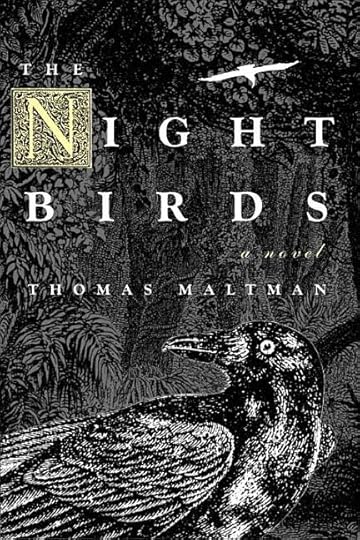
Recently, I discovered The Night Birds by Thomas Maltman—a historical fiction novel set before, during, and after the U.S. – Dakota War of 1862. Published in 2007 by Soho Press, it came as a surprise to me that I had not previously heard about this novel. Because of my interest in the U.S. – Dakota War and the interest of my readers, I decided to read The Night Birds and share my perspective on this fascinating novel.
The novel begins in 1876 at Kingdom Township, Minnesota, with a young boy named Asa Senger. Asa was born a few months after the U.S. – Dakota War of 1862 and knows little of what transpired along the Minnesota River Valley, being concerned instead with the locusts that continually ravage his family’s farm. However, circumstances change when Asa’s long lost Aunt Hazel arrives. Hazel was presumed dead shortly after the U.S. – Dakota War, but Asa learns that she had been spending her years in a St. Peter Mental Health Facility or insane asylum as it was called at the time. Hazel is quiet and strange, but Asa is curious and quickly develops a liking for his aunt.
From this point the novel takes us back to Aunt Hazel’s youth in Saline Springs, Missouri, in 1859. We learn that Hazel’s father is an abolitionist journalist who is run out of town for his opinions on slavery. This leads the family north where they eventually settle on the north side of the Minnesota River at the Milford Prairie. Across the river, along the Waraju Prairie, lives a small band of Wahpekute Dakota. Among the Wahpekute is Wanikiya, Savior, a Dakota boy who grows up tormented by his older brother. The two families, Dakota and white, regard each other strangely, but come to live as good neighbors with the children often playing together. That was, at least, until the death of Winona, a Dakota girl whose death was blamed on Hazel’s brother.
The novel continues, bouncing back and forth between Asa’s life at Kingdom Township in 1876, and Hazel’s life on the Milford Prairie in 1859-1862. Ultimately, Hazel’s story takes precedent as Minnesota is encountered by the tragic circumstances of the U.S. – Dakota War. Hazel is taken captive while her family is torn apart. However, Hazel discovers solace and hope with her Dakota captors and Wanikiya whom she eventually marries. In the end, Hazel loses everything and struggles to maintain her sanity. As for Asa, he learns the truth about Hazel which leads him to discover the truth about himself.
Although The Night Birds is slow in developing, it is quite effective in creating intriguing, realistic characters and setting. Maltman works hard to intertwine people and places in a way that becomes emotionally moving by the end. Furthermore, Maltman includes countless historical and cultural details that are accurate, humanizing, and work to make the novel incredibly interesting, while the characters make the novel compelling. Some of the historical details are slightly skewed or changed, especially those regarding the Spirit Lake Massacre of 1857, but once Maltman reaches the U.S. – Dakota War he includes little-known and well-known facts that were clearly derived from historical documentation. Finally, Maltman has strong, eloquent prose that brings the characters and settings to life and makes the novel delightful to read.
If you are interested in the lives of settlers and Dakota before and during the U.S. – Dakota War, and you enjoy literary fiction, I strongly recommend reading The Night Birds by Thomas Maltman. You can purchase a discounted copy in my online bookstore here.
September 15, 2019
Lessons from the Novel Resisting Removal: The Ojibwe Clan System
September 8, 2019
Lessons from the novel Resisting Removal: The Annuity Payment of January 1852
September 3, 2019
Free Kindle Ebook – Reviewers Wanted
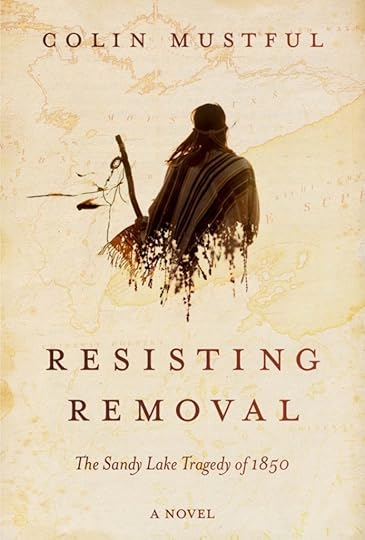
Resisting Removal: The Sandy Lake Tragedy of 1850, Colin Mustful’s new historical novel, will be officially released on September 30, 2019. Using real correspondence and documentation from the time period, Mustful’s novel tells the story of the Lake Superior Ojibwe’s efforts to resist the illegal removal efforts of the United States government and Minnesota territorial governor Alexander Ramsey. The story follows real-life interpreter Benjamin Armstrong who fights to help the Ojibwe keep their homeland on Madeline Island. After four hundred Ojibwe perish at Sandy Lake because of the negligence of U.S. government officials, the La Pointe Ojibwe, led by Chief Buffalo, travel all the way to Washington DC to express their grievances to the President. In 1854, through much heartache and after years of mistreatment and continued efforts to remove them, the Ojibwe finally earned a new treaty that promised permanent reservation homes in their homeland. But in the end, what was won and what was lost—and ultimately, whose narrative does history remember?
As the release date for his new novel approaches, Mustful is seeking honest and unbiased reviews on Amazon, Goodreads, and wherever book reviews are found. If you are interested in reviewing this compelling and historically detailed novel, email the author at mnauthor@colinmustful.com. Books are limited and will be awarded on a first-come-first-serve basis. Review copies are free and will be provided as an Amazon Kindle ebook.
August 25, 2019
Lessons from the Novel Resisting Removal: Leonard and Harriet Wheeler
August 18, 2019
Lessons from the Novel Resisting Removal: The Suspension of Removal Efforts
August 13, 2019
Mikwendaagoziwag Memorial Event
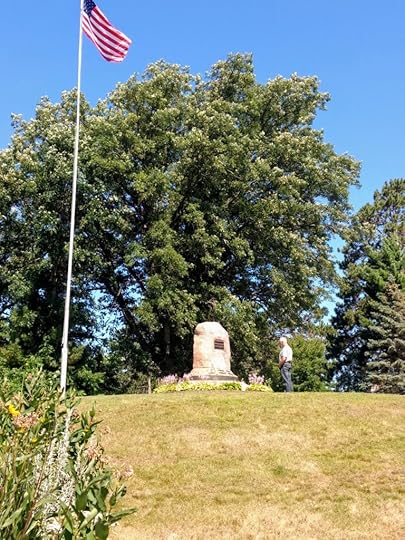 A man standing at the Sandy Lake Memorial
A man standing at the Sandy Lake MemorialEvery year on the last Wednesday in July, Anishinaabe people and their allies gather at Big Sandy Lake in northern Minnesota to commemorate the deaths of their ancestors while celebrating their perseverance and foresight. The event, which is hosted by the Great Lakes Indian Fish and Wildlife Commission, takes place near the Mikwendaagoziwag (We Remember Them) Memorial—a stone and plaque commemorating the Sandy Lake Tragedy of 1850. In that year, the Lake Superior Bands of Ojibwe were illegally forced to remove from their homes along to southern edge of Lake Superior to Sandy Lake in Minnesota Territory. But government officials did not provide promised rations or supplies and as a result more than 150 Ojibwe died at Sandy Lake. Then, because Minnesota’s Territorial governor intentionally delayed payment in order to trap the Ojibwe, another 230 died trying to return to their homelands in harsh winter conditions.
Today the Ojibwe mourn for and celebrate their ancestors beginning with a canoe paddle across Sandy Lake. When paddlers arrive on the opposite side of the lake they are welcomed and honored. Then, all those gathered are provided a free meal and given time to relax and socialize. The Mikwendaagoziwag Memorial Event closes with a time of ceremony, healing, and discussion. Numerous tribal leaders stood before the crowd of hundreds to talk about the sacrifices of their ancestors and the importance of remembering the Sandy Lake Tragedy so that it never happens again. But they also spoke of gratitude, expressing a great sense of thankfulness for everything they have and an appreciation for the wisdom of their leaders who, in 1854, earned a new treaty that gave them permanent reservation homes in their homeland.
It was a joy and a privilege to be a part of the 2019 Mikwendaagoziwag Memorial Event. I invite everyone to learn more about this history and to share it with others. A pamphlet published by the Great Lakes Indian Fish and Wildlife Commission provides an excellent overview and can be found here: https://files.constantcontact.com/7e1eef04401/dd6948ca-6033-4a17-9599-7a86f18856d8.pdf. You can also learn more by reading the novel Resisting Removal: The Sandy Lake Tragedy of 1850.
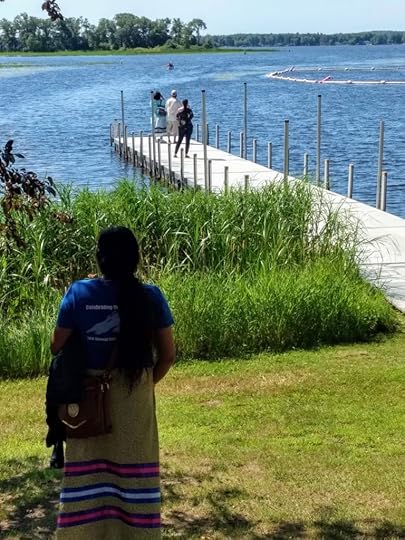 People welcome the first canoes arriving at the commemoration site.
People welcome the first canoes arriving at the commemoration site.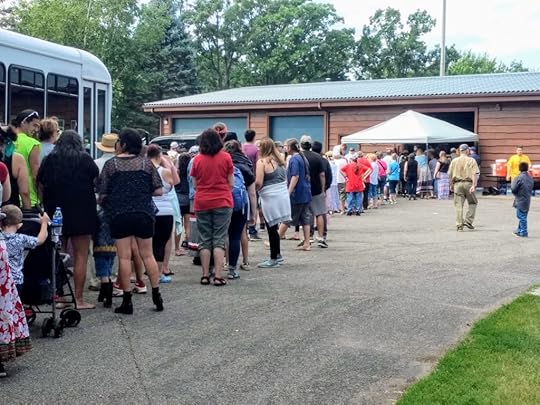 A long line for the food provided by GLIFWC
A long line for the food provided by GLIFWC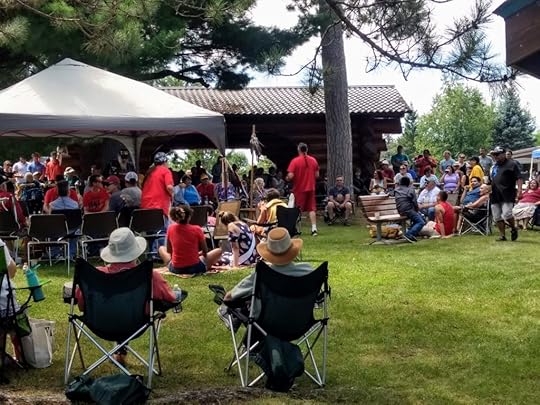 An Anishinaabe leader speaks of gratitude for the sacrifices and wisdom of his ancestors
An Anishinaabe leader speaks of gratitude for the sacrifices and wisdom of his ancestors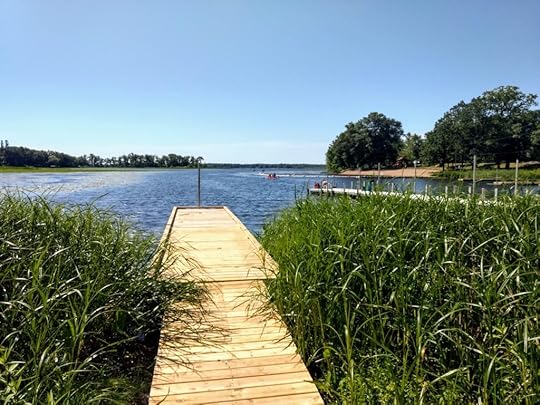 Paddlers arrive after a long journey across Sandy Lake
Paddlers arrive after a long journey across Sandy Lake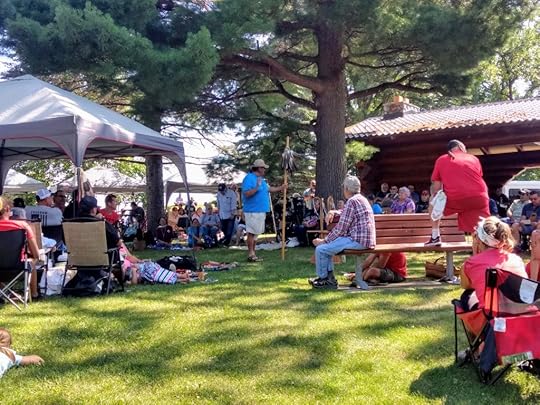 A talking circle of healing and remembrance
A talking circle of healing and remembrance
July 29, 2019
Lessons from the Novel Resisting Removal: Petitions Against Removal
July 19, 2019
MNopedia: Clark W. Thompson
 MNopedia is an online encyclopedia about significant people, places, events, and things in Minnesota History.
MNopedia is an online encyclopedia about significant people, places, events, and things in Minnesota History. Read my latest publication in MNopedia about Clark Wallace Thompson. Thompson is the founder of Wells, Minnesota, and was the Superintendent of Indian Affairs during the U.S. – Dakota War of 1862. He used his position to gain wealth and exploit Native populations in Minnesota. Learn more here: http://mnopedia.org/person/thompson-clark-wallace-1825-1885
July 14, 2019
Cultural Appropriation
Recently, I received the following comment on my website:
I am concerned that nowhere in your statement about your work does it say that you worked closely with the Tribal people about whom you are writing their history to ensure accuracy and their perspective is represented. Have you sought out the advice and consultation with Tribal governments? If not, you should state that the Tribes you write about in no way endorsed or were consulted in your work. If not, why not? Do you realize how damaging it is to Native people when their history gets appropriated and mis-represented? If yes, you have collaborated with Tribal governments, tribal communities, and elders who know the oral history about which you write, that would greatly strengthen confidence in your writings and should be included for transparency sake. A lot of people are going to read your books and assume you consulted with Tribes, but from what I’m reading, it doesn’t sound like you did.
The commenter raises important questions regarding the telling and retelling of history. When a person from one culture, background, or viewpoint, tells a story about people from another culture, background, or viewpoint, it is likely to create a conflict of representation. If the storyteller in any way misrepresents or claims ownership or authority over the history of which he or she tells, it is known as cultural appropriation. Cultural appropriation has a way of distorting the past. When the distorted history is proliferated, as it often is, it becomes so entangled with the truth that it can no longer be separated from the original history. This, as the commenter points out, is damaging to the people and cultures from which the history and stories originated. Sometimes, the damage is irreparable.
First, in response to the commenter, I’d like to acknowledge that I have no Native heritage. I was born in Minneapolis, Minnesota, to white parents. My great grandparents immigrated to this country in the late 19th and early 20th centuries from Norway, Ireland, Germany, and Turkey. Second, I would like to acknowledge that, while I have and will continue to reach out to Native communities in order to collaborate on this history, my work has not been endorsed by nor received specific feedback from Native people or communities. That is not to say I have not been in contact with numerous Native peoples about this history, but that my published works do not specifically reflect their direct insight. Rather, I have relied on a variety of published source materials whether they be Native authors, white authors, or otherwise. Thirdly, in response to this commenter, I will post a brief statement to my “About the Author” page in order to be completely transparent about who I am and the influences and perspectives that are reflected in my work.
Finally, I would like to state that this person’s comments do not diminish the value of my work or my perspective. Nor does it diminish the value of anyone’s perspective. Every person’s voice, feelings, perspectives, opinions, thoughts….have value and ought to be included in our ongoing historical dialogue. From my perspective, I am an educated, careful researcher, who, with utmost sincerity, has sought to convey a complicated past that has meaning to me as a Minnesotan, a historian, and a human being. I wish to incorporate the stories of all those for whom I write, seeing them as equal participants, whether they be considered moral or immoral, just or unjust.
I do not claim ownership over this or any history. Rather, I invite you to participate with me. What is your perspective? How has history affected you and your family? What obligations do you carry with you because of the past and how will you manage those obligations?
Contribute to history. Be honest about who you are and what drives your story. Do not appropriate the past, be a part of it.



